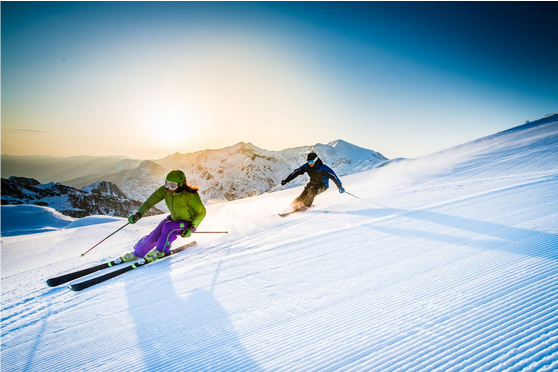Step 1: Strengthen
Think about the muscles you use the most when you ski: quadriceps, glutes, hamstrings. We’ve shared before about our love of dynamic stretching, and we recommend you revisit some of our favorite dynamic stretches before any winter workout. For ski strengthening, we recommend a combination of squat exercises to build up muscle strength and increase endurance.
- Squats: great for strengthening quads, glutes and hips
- We recommend three-to-four sets of 20 squats, two-to-three times a week
- Add a lightweight dumbbell to each hand to make the exercise more challenging
- Squat jumps: makes static squats dynamic and adds quick reaction to quads and glutes with a little cardio burst
- Try four sets of four squat jumps with a short break between sets to get started
- Land softly on your feet
- Wall Squats/Wall Sits: combines the strengthening benefit of a traditional squat with endurance
- Stand with your back against a wall and slide down to a squat position and hold as long as you can
- We recommend two-to-three wall sits with a short break in between, adding time to each wall sit as you progress
Step 2: Balance
Balance on the slopes seems like a no-brainer, but getting back into good skiing balance might not be as intuitive as you think. There are plenty of exercises that are helpful for building your balance back up, and we’re partial to these three:
- Lunges: A combination of strength building and balance in these simple exercises
- Step one leg forward and bend down so the right leg forms a right angle and your back knee hovers over the floor
- We recommended 20 repetitions three-to-four times on each side
- Walking Lunges: Adds a balance challenge to the traditional, static lunge
- Walking lunges allow you to lunge on one side, then the next, moving forward
- Place your hands on your hips and walk your lunges a few times on each side, or until you reach a natural stopping point; turn around and lunge back to your starting point
- Planks: A strong core is key to full-body balance, and the tried-and-true plank is a great way to build core strength
- Hold a tall push-up position with a flat back for 60 seconds (if you have discomfort in your wrists, rest on your forearms instead)
- Build up your plank in 15-second intervals until you can comfortably hold a plank for two minutes
Strong muscles and good balance are imperative to a safe and fun ski season, but don’t sleep on cardio. We recommend a combination of exercises and activities like brisk walking, jogging/running or stationary cycling to help prepare you for a long day on the hill.
- Lateral Ski Jump Exercise: This exercise has “ski” in its name, and it’s a clear winner for ski readiness. You’ll hit strengthening, balance and endurance in one move—plus, it’s pretty fun.
- Stand with your feet hip-width apart with knees slightly bent, balancing on one leg
- Jump to the side, landing on the other leg (and land softly)
- Jump to the other side, and move your arms across your body like a speed skater as you jump back and forth in quick succession
- Pick your rep style: hit 15 jumps on each side or set a timer for 30 seconds—increase your reps or timer as you get more comfortable with the movement
- Dedicated Cardio: Nothing is going to improve your stamina like cardiovascular exercise, but beginning a cardio regimen from the ground up can be challenging. Start small—take the stairs instead of the elevator, for example—and build up as you get more comfortable. Ideas to get started:
- Take it in Fives and Tens: Choose your cardio (brisk walk, jog, stationary bike) and begin with a ten-minute session. Then take a five-minute break to stretch and catch your breath. Feel better after five? Try another ten-minute session of cardio and continue as you feel comfortable. Once you’re good with ten minutes of dedicated exercise, increase your sessions by five minutes to fifteen, twenty, etc. until you build to at least 30 minutes of sustained cardio exercise without a break.
- Mix it Up: Alternating between different types of cardio can help keep the workouts fresh, while ensuring you’re hitting different muscle groups (remember strengthening and balance as steps 1 and 2?). Mix up your brisk walks with a HIIT class, cycling session, or jog.
Step 4: Shred
With a combination of strength, balance and endurance, you’re ready to get after it on the hill. As you get started, remember to take breaks and listen to your body’s cues. Feeling the burn in your quads? Be sure to stretch or foam roll after you ski to help your body recover.


